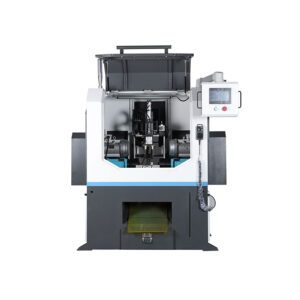Struggling with pipe burrs affecting the quality of your products? Burrs not only create difficulties during installation but can also lead to safety issues or performance problems. Finding the best way to remove burrs is crucial for ensuring smooth operations.
The most effective methods for removing burrs from pipes range from manual tools to advanced CNC machines, each catering to different production needs and budgets.
Let’s explore 10 ways to effectively remove burrs from pipes and improve your process.
1. Using Manual Deburring Tools
Manual tools are often the go-to option for small-scale operations or precision work.
Manual tools like files and scrapers are simple to use and allow for detailed work, but they can be time-consuming and labor-intensive.
This method is highly flexible—you can use it on any pipe size or shape. However, the quality of the deburring depends on the operator’s skill and experience, making it less suitable for high-volume production where consistency and speed are key concerns.
2. Mechanical Deburring Machines
Mechanical deburring machines are ideal for standardized, high-volume production.
These machines are fast and efficient, automatically removing burrs with consistent results, which significantly increases productivity compared to manual deburring.
Mechanical deburring machines excel in medium to large manufacturing plants where processing time and labor costs are important. The initial investment may be high, but the machine pays off through labor savings and increased production capacity.
3. Using CNC Chamfering Machines

CNC chamfering machines are the perfect solution when precision and high-quality finishes are required.
These machines can remove burrs with incredible accuracy and ensure that every pipe has a consistent chamfer, which is critical for industries like automotive and aerospace.
CNC chamfering machines offer programmable control, which means you can customize the process according to the material and pipe size. While the upfront cost is significant, they are excellent for high-end production that demands perfection.
4. Vibratory Finishing
Vibratory finishing uses abrasive materials in a vibrating bowl to remove burrs from small or irregularly shaped pipes.
This method is quick and uniform, making it great for handling a large batch of small parts in one go.
Vibratory finishing is excellent for treating small pipes, and it works well in conjunction with other deburring processes. However, it’s not ideal for larger diameter pipes, and additional finishing may be required to achieve a completely smooth surface.
5. Deburring with Brushes
Using brushes to deburr is a softer approach, suitable for removing minor burrs or polishing the pipe surface.
Rotating metal or nylon brushes are used to clean and deburr both the inner and outer surfaces of pipes, especially thin-walled ones.
This method works well for delicate pipes, as it minimizes surface damage. Brush deburring is ideal for achieving a smooth finish, though it’s generally slower than more aggressive techniques like mechanical deburring.
6. Chemical Deburring
Chemical deburring involves using chemical solutions to dissolve burrs, especially in hard-to-reach areas.
This process is particularly useful for precision industries like aerospace and medical devices, where maintaining the integrity of the pipe’s surface is crucial. The chemical removes burrs without affecting the rest of the material.
However, proper disposal of the chemical solution is essential to meet environmental standards, and it’s often used in combination with other deburring methods for a flawless finish.
7. Thermal Deburring
Thermal deburring uses high temperatures to burn away burrs in a matter of seconds, ideal for intricate or high-precision parts.
This method is extremely fast and effective, but requires specialized equipment. The high cost makes it suitable for industries where precision is paramount, such as automotive and aerospace.
While the results are excellent, thermal deburring can be an expensive solution, especially for smaller operations or when burrs are minimal.
8. Ultrasonic Deburring
Ultrasonic deburring uses high-frequency sound waves to remove tiny burrs, particularly from the interior of pipes.
This method provides precise deburring, making it ideal for industries that demand high precision and minimal damage to the workpiece, such as medical equipment and electronics manufacturing.
Though effective, ultrasonic deburring equipment can be costly and is generally used for high-end applications where perfection is required.
9. Electrochemical Deburring
Electrochemical deburring removes burrs through an electrochemical reaction, ideal for removing burrs from complex or hard-to-reach areas of pipes.
This method works well for large-scale production as it can process multiple pipes simultaneously and doesn’t introduce mechanical stress into the material. It’s particularly useful in the automotive industry for deburring components.
However, the downside is the need for special equipment and maintenance, especially concerning the chemicals involved in the process.
10. Laser Deburring
Laser deburring is a cutting-edge solution that uses high-energy laser beams to precisely remove burrs from pipes without any physical contact.
Laser technology provides unmatched accuracy, making it ideal for high-tech industries like aerospace and medical devices where the quality of the finish is crucial.
Although highly efficient, laser deburring requires significant upfront investment and is best suited for operations requiring precision and high-quality finishes on intricate pipe structures.
Conclusion
Selecting the right method for burr removal depends on your specific production needs. Evaluate your volume, budget, and required precision to choose the best solution.
Citations:
[1] https://www.tubesmachinery.com
[2] https://www.youtube.com/watch?v=pN1Fxui2Nkk
[3] https://gearsolutions.com/features/deburring-with-cnc-machining/
[4] https://gravostar.com/en/deburring/deburring-tools/
[5] https://deburringtechnologies.com
[6] https://www.harveytool.com/products/featured-solutions/deburring
[7] http://www.js-lyjx.com/proinfo/59
[8] http://www.hjztgh.com/product/hbbw.html






One Response